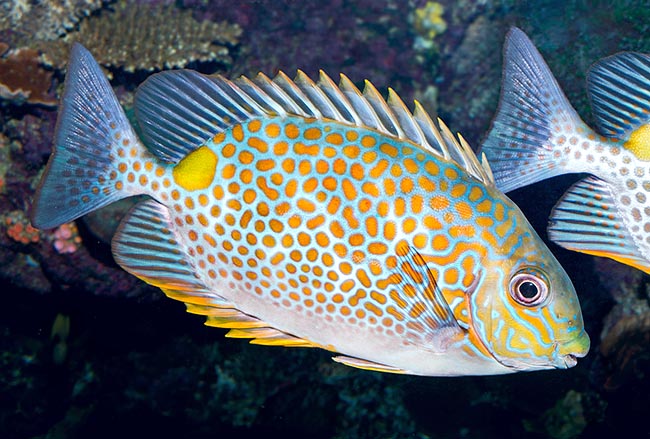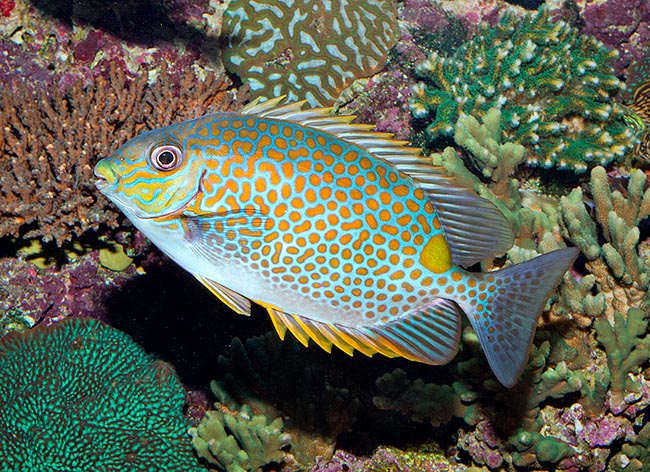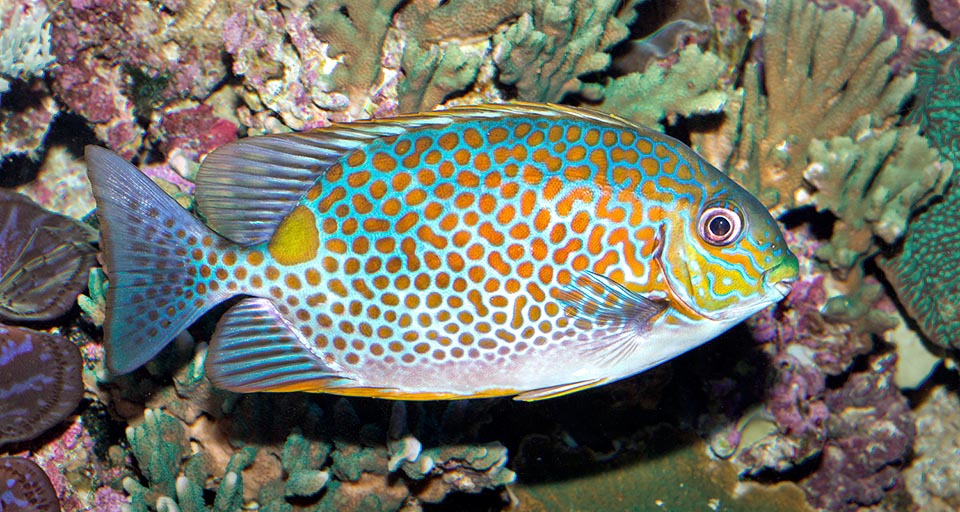Family : Siganidae

Text © Giuseppe Mazza

English translation by Mario Beltramini

With a record of 42 cm, Siganus guttatus is one of the largest members of the family © Giuseppe Mazza
Marine but also sometimes brackish waters fishes. They rarely exceed the 40 cm and at times play an important rôle in the human feeding.
The etymology of the genus Siganus comes from the Arab word “sidjan”, a name gathered by Forsskål in his travel towards the East and assigned by him to the Siganus rivulatus Forsskål & Niebuhr, 1775.
The specific name guttatus, that in Latin means mottled, speckled, refers to the characteristic and elegant mimetic pattern with arabesques and spots.
Zoogeography
The Siganus guttatus has a vast diffusion area in the tropical waters of the Eastern Indian Ocean and of Western Pacific, which is its origin birthplace. To the east it appears that it’s colonizing the Vanuatu Archipelago and to the west even Tanzania; data still to be verified because it light be the case of only some erratic individuals. It is by sure present in Indian, in the Andaman Islands, in Thailand, Malaysia, Singapore, Indonesia, Australia, Palau and Micronesia and, northernmost, Philippines, Vietnam, Taiwan, Ryukyu Islands, Japan and China. In the southwestern region of the Pacific, towards east of its distribution area, it is replaced by the analogous Siganus lineatus , of similar size, with the same yellow spot close to the caudal peduncle, but with the spots that merge to form long arabesques. Where the two species do overlap, some hybrids often take form.

At home in the tropical Indo-Pacific is one of the few siganids active by night © Giuseppe Mazza
The goldlined spinefoot usually swims in shallow waters, not under the 25 m of depth, among the madreporic fomations and along the rocky coasts, but quite often also in brackish waters at the mouth of the rivers, where goes up till when the salinity is of the 50%, and in the mangrove forests.
Morpho-physiology
Apart the drawing, it somewhat recalls the Double-barred spinefoot Siganus virgatus: same lips, but the shape is slightly longer and the size is larger. The oval body, flattened on the sides, can in fact exceed the 40 cm, even if the normally fished one is of about 25 cm.
The dorsal fin has 13 spiny rays and 10 unarmed, the anal 7 spiny and 9 unarmed rays. The big pectoral ones have 15-16 soft rays and the ventral 2 spiny rays and unarmed. The tail, almost truncated in the young specimens, is forked.
Like the Siganus virgatus it has the spiny rays imbued with a powerful poisonus mucus, luckily thermolabile, that causes painful wounds. Typical of the species is the elegant livery with yellow-orange spots on green-turquoise background that embellish also the caudal fin and the peduncle. Over this, as is the case for the Siganus lineatus, stands a huge yellowish spot that creates on the opposite side of the head a fake eye to confuse the aggressors in the darkness. It is in fact, unlike other Siganus, a species with nocturnal habits.
Ethology-Reproductive Biology
When it doesn’t fall into the nets to end in the local markerts, the Siganus guttatus, in fact eats during the night time. The main course consists also here in weeds and aquatic plants, without forgetting the benthic invertebrates it finds along the corals and in the submerged prairies.

Splendid livery but spines imbued with poison, simulates in the dark a fake eye to confuse aggressors © Giuseppe Mazza
The resilience is excellent, in fact less then 15 months are enough for doubling the populations decimated by the events, and the vulnerability index is incredibly low: just 19 on a scale of 100. The local fishing is therefore sustainable and the species in fact is in no danger at all. Due to the beauty of the colours, as you will note here below in the synonyms, Bloch has compared it to a Chaetodon, but has nothing to fear on the aquarists side, seen the big size and the insatiable polluting vegetarian appetite.
Synonyms
Chaetodon guttatus Bloch, 1787; Amphacanthus guttatus Bloch, 1787; Teuthis guttata Bloch, 1787; Amphacanthus concatenatus Valenciennes, 1835; Teuthis concatenata Valenciennes, 1835; Amphacanthus firmamentum Valenciennes, 1835.
→ For general information about FISH please click here.
→ For general information about BONY FISH please click here
→ For general information about CARTILAGINOUS FISH please click here.
→ To appreciate the BIODIVERSITY of BONY FISH please click here.
→ To appreciate the BIODIVERSITY of CARTILAGINOUS FISH please click here.
